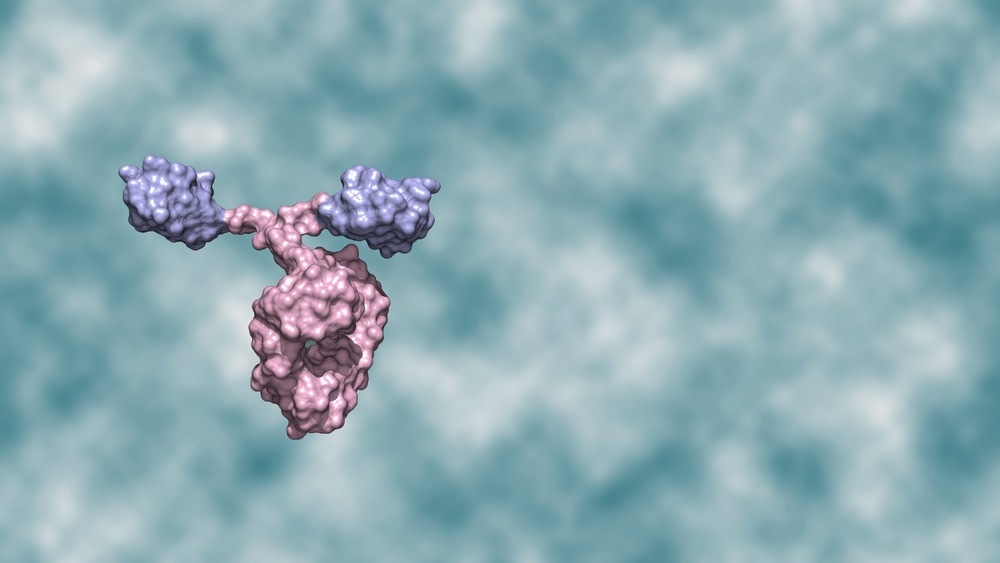The coronavirus disease 2019 (COVID-19) pandemic, caused by the rapid outbreak of severe acute respiratory syndrome-coronavirus 2 (SARS-CoV-2), has drastically affected the healthcare system and economy worldwide. Several COVID-19 vaccines have received emergency use authorization (EUA) from global regulatory bodies, such as the U.S. Food and Drug Administration (FDA). Due to the continual emergence of SARS-CoV-2 variants owing to genomic mutations, the efficacy of the available vaccines against some strains of the virus has been reduced.
 Study: A humanized nanobody phage display library yields potent binders of SARS CoV-2 spike. Image Credit: Huen Structure Bio/Shutterstock
Study: A humanized nanobody phage display library yields potent binders of SARS CoV-2 spike. Image Credit: Huen Structure Bio/Shutterstock
Background
There is an urgent need for novel, cost-effective, high-throughput, and adaptable pipelines to identify effective therapeutics against COVID-19 and other similar viruses that can potentially cause pandemics.
Mechanistically, the spike protein of SARS-CoV-2 is responsible for host invasion. This protein detects and binds to the host’s angiotensin-converting enzyme 2 (ACE2) and promotes the fusion of membranes to cause host infection. SARS-CoV-2 genomic mutations, such as N501, have been associated with increased transmissibility and virulence compared to the original SARS-CoV-2 strain that emerged in Wuhan. Additionally, some variants can escape immune responses elicited after COVID-19 vaccination or natural infection.
Camelidae and some shark species contain nanobodies known to be a unique class of heavy chain-only antibodies. Nanobodies (VHHs) and shark variable new antigen receptors (VNARs) are smaller by one order of magnitude than full-length IgG counterparts. The main advantage of utilizing these nanobodies as antiviral biologics is easy bulk production at a multi-kilogram scale in a prokaryotic system. Additionally, nanobodies have a longer shelf life and higher tissue permeability.
Nanobodies are administered via different routes, for example, orally (e.g., V565) or by inhalation (e.g., ALX-0171). A recent PLoS ONE study detected neutralizing nanobodies against SARS-CoV-2 from nanobody phage display libraries and via in vitro and ex vivo high-throughput screenings.
Key findings
Synthetic humanized nanobody libraries were developed by combining randomized complementarity-determining regions (CDRs) framework to diversify antigen recognition. Among the ten enriched RBD binders, RBD-1-2G(NCATS-BL8125) and RBD-2-1F were the most potent exhibiting an IC50 of 490 and 470 nM against SARS-CoV-2 pseudotyped particles, respectively.
The development of bi- or tri-valent formats of the RBD-1-2G domains enabled an enhanced affinity and neutralization capacity against both pseudotyped particles as well as the SARS-CoV-2 virus. Further, two distinct binding modes were noted for four nanobodies in conjunction with a stable SARS-CoV-2 S-protein ectodomain. The epitope for ‘Group 1’ nanobodies was found to overlap with the receptor binding motif (RBM), while the N-terminal domain of the adjacent monomer was targeted by the ‘Group 2’ binders. The latter failed to inhibit ACE binding and did not overlap with the RBM.
It was also observed that 3 copies of RBD-1-2G could bind to the same spike trimmer. Pseudotyped particles containing the N501Y mutation were neutralized by the RBD-1-2G nanobody. The viral loads in WA1 and B.1.1.7 infections were reduced by RBD-1-2G-Fc treatment, and molecular dynamic simulations shed light on nanobodies that bound epitopes solely focussed on the spike-ACE2 interface. It was noted that one of the reasons for the affinity of RBD-1-2G to B.1.1.7 RBD could be the presence of the tyrosine in position 501.
To determine the effect of the mutation on the nanobody, the B.1.1.7/Alpha (N501Y) was used, which enhanced the RBD binding to the ACE2 receptor. RBD-1-2G could bind to both the Alpha (N501Y) and WT RBD but not to new mutant lineages, which could be caused by the E484 mutations. Binding was also absent with the Delta and Lambda variants, which do not have the E484 mutation.
Future perspectives
Nanobodys’ effectiveness as therapeutics are mainly driven by factors such as protein solubility, potential immunogenicity, and binding affinity. Several new approaches have been reported concerning developing effective therapeutics against the SARS-CoV-2 spike domain. Previous research showed that direct immunization of llamas produced effective nanobodies that neutralize pseudotyped particles in the low nanomolar range. In the future, the technology to produce llama hybridomas should be developed.
In a recent study, anti-SARS-CoV-2 binders were generated using ribosome-display of synthetic llama libraries by performing an affinity maturation step. Subsequently, a mutagenized library was created by combining the sequences. In a similar vein, such an affinity maturation process could be helpful for the RBD-1-2G binder to assist in restoring binding to novel SARS-CoV-2 mutants.
Rapid screening of artificial humanized nanobody libraries to detect compatible binders could be beneficial for countering the immunogenic defenses possessed by viral pathogens. The discovery method described in this study was able to generate high-affinity llama binders in a short span of fewer than two weeks. In the future, the library could be used in the treatment of other diseases besides COVID-19 and act as a reserve for quick neutralizing nanobodies discovery.